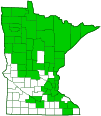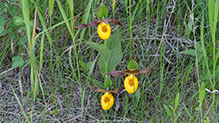northern small yellow lady’s slipper
(Cypripedium parviflorum var. makasin)
Conservation • Wetland • Description • Habitat • Ecology • Use • Distribution • Taxonomy
Description |
Northern small yellow lady’s slipper is a 4¾″ to 17¼″ tall, erect, perennial forb that rises on one to several stems from a rhizome and fleshy, widely-spaced roots. The stems are erect, round, stout, green, and densely hairy. The hairs on the stems and leaves cause dermatitis in some people. There are 2 to 5 leaves on the flowering stem. The leaves may be crowded near the top of the stem or evenly spaced along the stem. They are alternate, erect to spreading, stalkless, and hairy. The leaf blades are broadly egg-shaped to elliptic lance-shaped, 2⅜″ to 6¼″ long, and 1″ to 3″ wide. They wrap around (sheath) the stem at the base and taper to a point at the tip. There are several prominent parallel veins arcing from the base to the tip. The veins are deeply impressed on the upper surface. The upper surface of the mature leaf blade is yellowish-green to dark green and hairless. The lower surface is similarly colored and is hairy along the main vines. The margins are untoothed and have a fringe of hairs. The inflorescence is usually 1, sometimes 2, flowers at the end of the stem. The flowers appear between May 20 and June 30, with peak blooming time June 5 to June 15. The flowers are held upright at the end of a hairy flower stalk. There is a single, 15 ⁄16″to 2¾″long, modified leaf (bract) on the flower stalk just below the flower. The upper surface of the bract is sparsely and inconspicuously covered with hairs when young. The flower has 3 sepals and 3 petals. The upper sepal is egg lance-shaped, erect, wavy, somewhat twisted, and ¾″ to 1½″ long. It is yellowish-green but partly to mostly suffused with dark red or reddish-brown. The two lateral sepals are united for most of their length, divided at the tip, appearing to be a single sepal (synsepal). The synsepal droops downward below the lip and is similar in size and appearance to the upper sepal. The lateral petals are linear lance-shaped and 1″ to 2″ long. They are spreading to strongly drooping, usually spirally twisted or wavy, and similar in color to the sepals. The lower petal (lip) is inflated to form a large, showy, slipper-like pouch. The lip is ¾″ to 1¼″ long and yellow, with red spots near the opening and on the inside surface. The margins of the opening on the upper portion of the lip are rolled inward. As with most Orchidaceae, the filaments and style are united to form a column. There are 2 stamens, one on either side of the column, and an enlarged, triangular, yellow staminode at the tip of the column. The fruit is an erect, ellipse-shaped, ribbed, 1″ to 1¼″ long capsule. |
Height |
4¾″ to 17¼″ |
Flower Color |
Yellow |
Similar Species |
Large yellow lady’s slipper (Cypripedium parviflorum var. pubescens) is usually a taller plant with larger leaves, sepals, petals, and lip. However, there is a continuous gradation in size and the sizes overlap, making size not always a reliable indicator. The sepals and lateral petals are lighter, appearing mostly yellowish-green with reddish-brown streaks. Unfortunately, there is a continuous gradation in this character as well. In Native Orchids of Minnesota, by Minnesota State Botanist Welby Smith, the author suggests “Perhaps everything that is not clearly var. makasin should be called var pubescens.” |
Habitat |
Wet to moist. Swamps, fens, and roadside ditches, especially rich conifer swamps on moss-covered peat. Northern small yellow lady’s slipper inhabits wet areas. It is found in the northeastern Minnesota in rich conifer swamps on moss-covered peat. In the lower Minnesota River valley it is found in calcareous fens. In northwestern Minnesota it is found in wet prairies, wet meadows, and wet aspen woodlands. It is also found in hardwood swamps, upland hardwood forests, and roadside ditches. |
Ecology |
Flowering |
May 20 to June 30 |
Pests and Diseases |
|
Use |
|
Distribution |
||
|
Sources Smith, Welby R. 2012. Native Orchids of Minnesota The University of Minnesota Press, Minneapolis, MN. Biodiversity occurrence data published by: Minnesota Biodiversity Atlas (accessed through the Minnesota Biodiversity Atlas Portal, bellatlas.umn.edu, 6/10/2024). |
|
| 6/10/2024 | ||
Nativity |
||
Native |
||
Occurrence |
||
|
||
Taxonomy |
|
Kingdom |
|
Division |
Tracheophyta (Vascular Plants) |
Subdivision |
Spermatophytina (Seed Plants) |
Class |
Liliopsida (Monocots) |
Order |
Asparagales (Agaves, Orchids, Irises, and Allies) |
Family |
Orchidaceae (orchids) |
Subfamily |
Cypripedioideae (slipper orchids) |
Genus |
Cypripedium (hardy slipper orchids) |
Subgenus |
Cypripedium |
Section |
Cypripedium |
Subsection |
Cypripedium |
Species |
|
Subordinate Taxa |
|
|
|
Synonyms |
|
Cypripedium calceolus ssp. parviflorum Cypripedium calceolus var. parviflorum Cypripedium parviflorum var. makasin |
|
Common Names |
|
lesser yellow lady’s slipper lesser yellow lady’s-slipper northern small yellow lady’s slipper northern yellow lady’s slipper small yellow lady’s slipper small yellow ladyslipper |
|
Glossary
Bract
Modified leaf at the base of a flower stalk, flower cluster, or inflorescence.
Column
The united filaments and style of an orchid. The structure formed by the united filaments of plants in the Mallow family.
Filament
On plants: The thread-like stalk of a stamen which supports the anther. On Lepidoptera: One of a pair of long, thin, fleshy extensions extending from the thorax, and sometimes also from the abdomen, of a caterpillar.
Rhizome
A horizontal, usually underground stem. It serves as a reproductive structure, producing roots below and shoots above at the nodes.
Sepal
An outer floral leaf, usually green but sometimes colored, at the base of a flower.
Synsepal
A floral structure formed by the partial or complete fusion of two or more sepals.
Visitor Photos |
||
Share your photo of this plant. |
||
This button not working for you? |
||
Dan W. Andree |
||
 |
||
Lesser Lady's Slipper... I seen these 6-6-25 and believe they are lesser yellow lady slippers. |
||
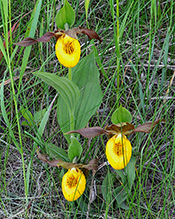
|
||
3 Yellow Lady Slippers... |
||
|
||
|
||
|
||
| Yellow Lady Slippers... |
|
|
Claire Althoff |
 |
Found this while spraying for poison ivy. |
Bill Reynolds |
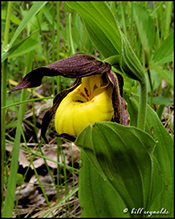 |
MinnesotaSeasons.com Photos |
||
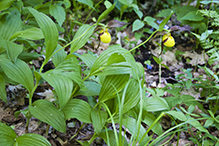 |
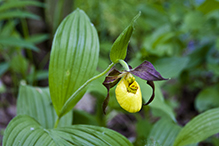 |
|
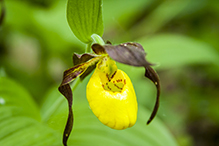 |
 |
|

Slideshows |
|

Visitor Videos |
||
Share your video of this plant. |
||
This button not working for you? |
||
|
Other Videos |
||
|

Visitor Sightings |
||
Report a sighting of this plant. |
||
This button not working for you? |
||
| Dan W. Andree 6/8/2024 |
Location: Norman Co. Mn. I seen these 6-6-25 and believe they are lesser yellow lady slippers. |
 |
| Dan W. Andree 6/8/2024 |
Location: Frenchman’s Bluff SNA |
 |
| Claire Althoff 6/4/2021 |
Location: Ottertail MN Nice clump (7-8) slippers |
 |
Susan M Smith |
Location: McGrath, MN |
| Bill Reynolds 6/15/2014 |
Location: Pennington County |
 |
MinnesotaSeasons.com Sightings |
||

|
Created: 4/23/2009 Last Updated: © MinnesotaSeasons.com. All rights reserved. |
